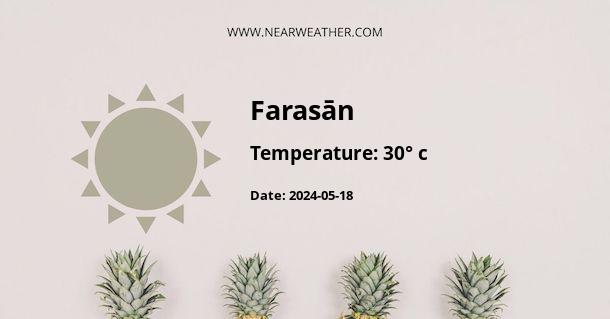Overview of Farasan, Saudi Arabia
Farasan, an archipelago in the Red Sea, is a part of Jizan Province in southwestern Saudi Arabia. Its largest island, Farasan Island, is a significant tourist attraction owing to its pristine beaches, clear waters, and rich biodiversity. While the region is predominantly known for its picturesque landscapes and wildlife, Farasan's climate plays a vital role in shaping its natural beauty.
Climate of Farasan
Farasan has a tropical desert climate, characterized by high temperatures and low rainfall throughout the year. The Köppen-Geiger classification for this climate is 'BWh'. This means the average annual temperature is above 18°C (64.4°F), and precipitation is less than 50% of the threshold required to classify it as a tropical savanna climate.
Weather Year-Round in Farasan
Temperature
The average temperature in Farasan ranges from 25°C to 35°C (77°F - 95°F) throughout the year. The warmest month is June, with an average high of 35°C (95°F) and an average low of 28°C (82.4°F). Conversely, January is the coolest month, with an average high of 29°C (84.2°F) and an average low of 21°C (70°F).
| Month | Average High (°C) | Average Low (°C) |
|---|---|---|
| January | 29 | 21 |
| June | 35 | 28 |
Precipitation
Rainfall in Farasan is scarce, with the rainy season typically occurring between May and July. The average annual rainfall is approximately 70 mm (2.8 inches), with July being the wettest month, recording an average of 20 mm (0.8 inches) of rainfall.
| Month | Average Rainfall (mm) |
|---|---|
| July | 20 |
Humidity and Wind
The relative humidity in Farasan typically fluctuates between 40% and 85%, with November being the most humid month. The region experiences a predominant northwestern wind, with an average speed of 5-15 km/h (3-9 mph).
Impact of Climate on Farasan's Biodiversity
Farasan's tropical desert climate has played a critical role in shaping its unique biodiversity. The high temperatures and low rainfall have given rise to a range of desert-adapted plant and animal species. This includes various types of cacti, succulents, and hardy shrubs, as well as wildlife species such as gazelles and desert hares.
Conclusion
In conclusion, Farasan's tropical desert climate, characterized by high temperatures and low rainfall, creates a unique environment that draws tourists and nature enthusiasts from around the globe. It's a testament to nature's resilience and adaptability, offering a diverse range of flora and fauna that thrive in these harsh conditions. Whether you're looking to explore its pristine beaches or delve into its rich biodiversity, Farasan offers a unique experience that is deeply interwoven with its climate.
A - Farasān's Latitude is 16.702221 & Longitude is 42.118328.
A - Weather in Farasān is 26° today.
A - Climate Conditions in Farasān shows overcast clouds today.
A - Humidity in Farasān is 78% today.
A - Wind speed in Farasān is 36.5 km/h, flowing at 173° wind direction. today.
